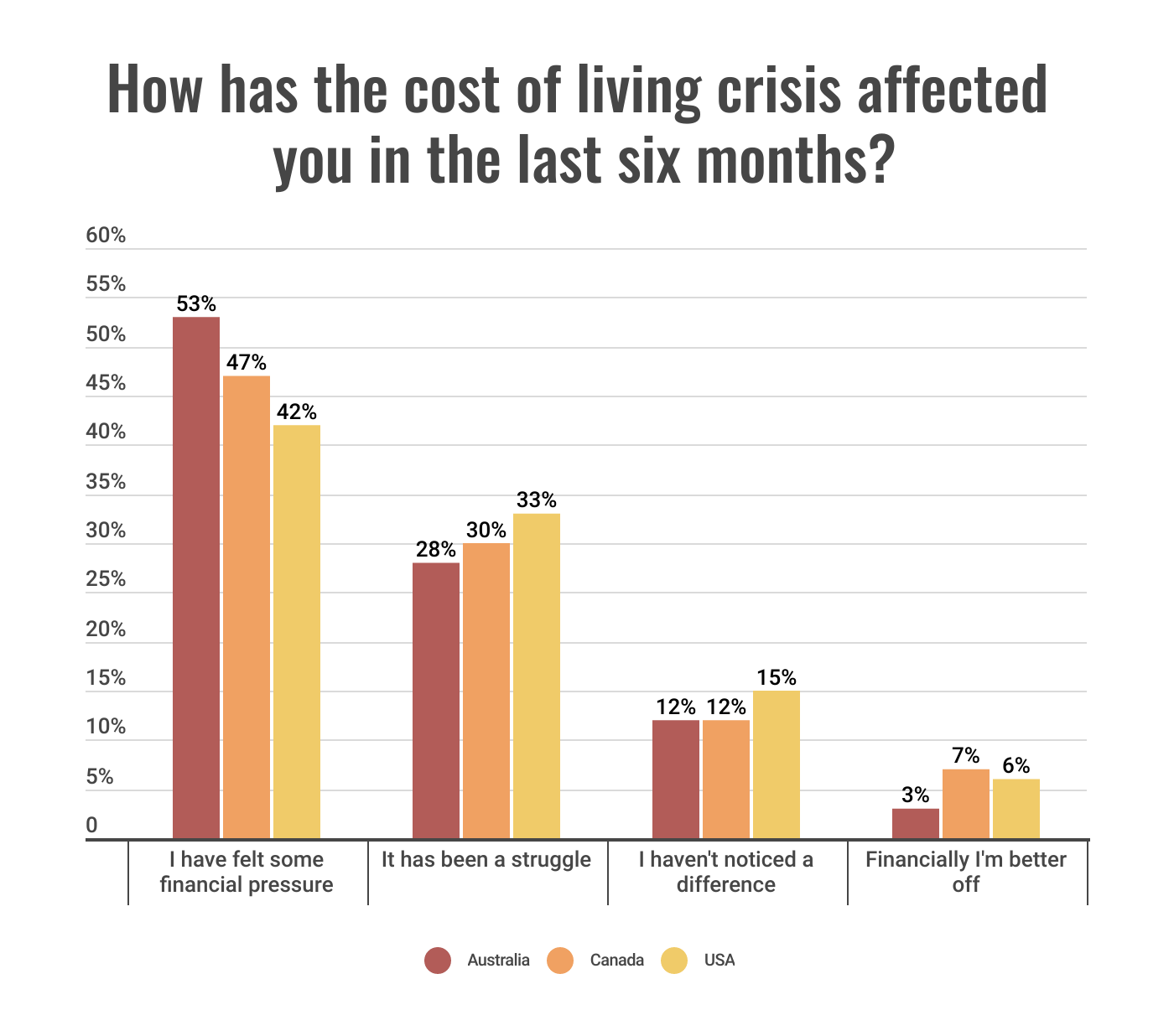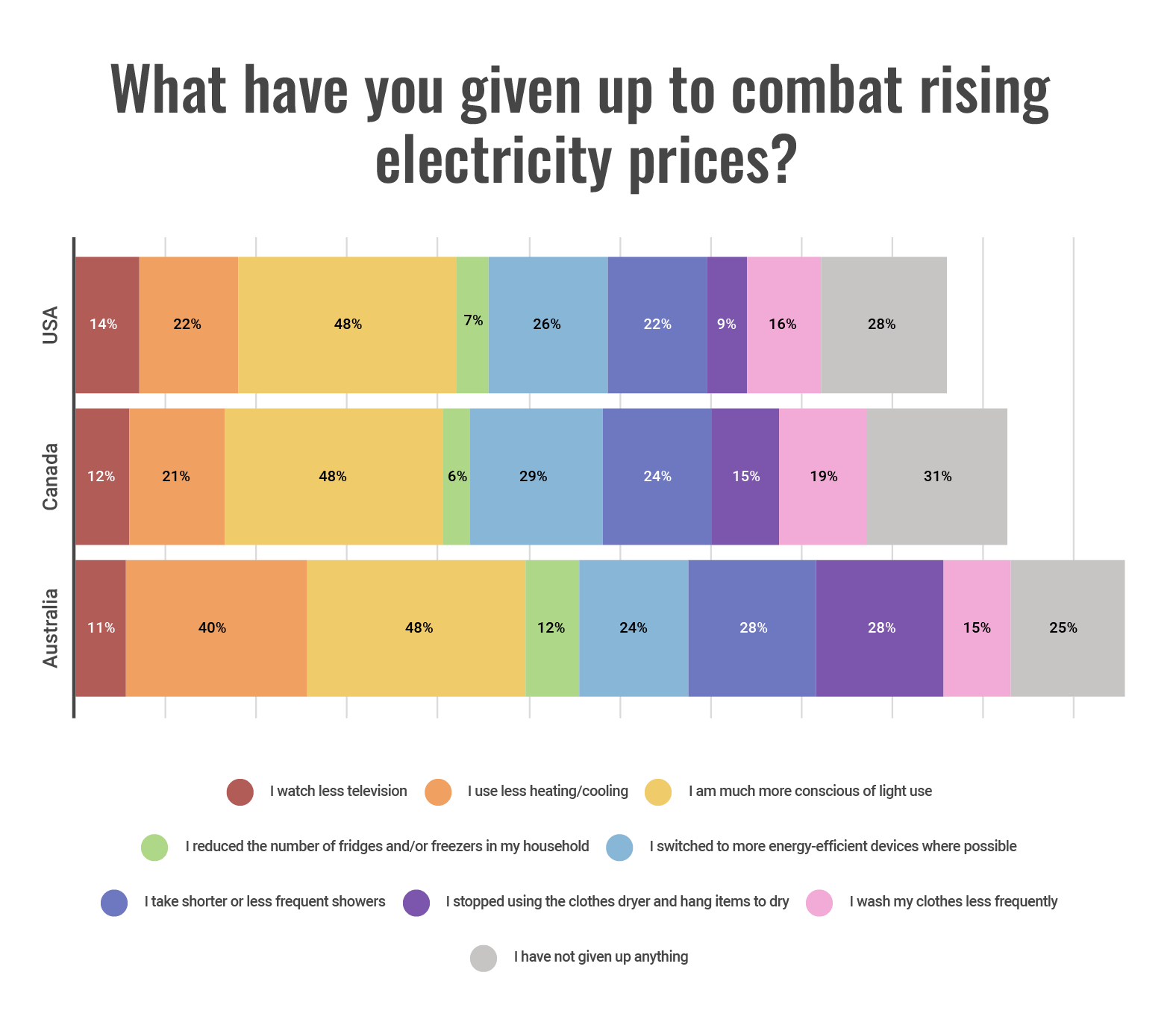The Burrow
With rising energy costs eating up more of our income in the midst of a wider cost-of-living crisis, people across the world are being faced with tough choices on what they’re willing to give up to cut down on expenses and save money.
It’s a bleak situation that isn’t going away anytime soon.
So, how are people cutting down on energy costs? What else are we willing to sacrifice to help save money?
To find out how rising energy bills and the cost-of-living crisis is affecting people, the energy experts at Compare the Market commissioned a survey of more than 3,000 adults across Australia, Canada and the USA.
Here’s what we found.
Times are tough. We’re all feeling it. As our survey revealed, most people have been impacted negatively.
On average, 30% of adults surveyed (combining Australia, Canada and US results together), or almost one-in-three people, said they had been really struggling and feeling the squeeze financially over the past six months.
The USA had the highest portion of people on struggle street at 33%, followed by Canada at 30% and Australia at 28%.
An even bigger cohort of people said they had felt financial pressure to a slightly lesser degree – more than half of all Australians surveyed (53%), 47% of Canadians and 42% of Americans said they had felt some financial pressure in the past six months.
Fortunately for some, they hadn’t noticed the rising cost of living, and almost one-in-ten Canadians (7%) said they were in a better financial position now than six months ago.

In a trend that will repeat itself throughout these survey results, more women were really struggling financially in the past six months than men – across all three countries surveyed.
Canada had the biggest difference with 35% of women and 25% of men saying there were struggling, a difference of 10%. In the USA, the difference was 9% with 37% of women and 28% of men feeling the squeeze. Australia had the smallest gap of 8%, as 32% of women and 24% of men surveyed said they were struggling financially.
When asked about other sacrifices people are making to fight the cost of living, the number one choice across all three countries was spending less on social events and entertainment (62% in Australia, 55% in Canada and 49% in the USA).
Interestingly, the second and third-most common responses to the question were also the same in every country surveyed: spending less on groceries at number two and reducing or changing energy usage habits at number three (48% / 36% in Australia, 45% / 31% in Canada and 38% / 31% in the USA).
| Sacrifice/habit change | Australia | Canada | USA |
| Social events and entertainment | 62% | 55% | 49% |
| Groceries | 48% | 45% | 38% |
| Energy usage | 36% | 31% | 31% |
| A Holiday | 26% | 26% | 20% |
| Health check-ups | 25% | 10% | 18% |
| Changed my living situation | 16% | 17% | 19% |
| Changed my job | 5% | 8% | 9% |
| Other | 1% | 2% | 1% |
| I have not sacrificed anything | 17% | 20% | 24% |
As before, there were noticeable gendered differences in the proportion of men and women making these sacrifices.
In all countries, women were more likely to cancel or postpone health checks. In Australia, the gap was the biggest between the sexes with 30% of women sacrificing health check-ups compared to just 19% of men – a difference of 11%. The USA had the next biggest gap at 5% (21% of women vs 16% of men), while Canada had the smallest gap of 3% (11% of women vs 8% of men).
Another big difference included groceries. More women were cutting back on groceries than men in all three nations. In Australia the difference was 20% (57% of women cut down their grocery shop compared to 37% of men). In Canada the difference was 12% (51% of women vs 39% of men) while in The States there was a 10% gap (43% of women and 33% of men).
Perhaps an ‘easy fix’, the number one method across the board for reducing household electricity bills was being more conscious of light use. Exactly 48% of respondents from all three countries said that was their preferred way of lowering electricity bills.
When looking at the top methods by country, in Australia light consciousness was followed by using less heating/cooling (40%), as well as taking less frequent showers (28%) or hanging washing to dry instead of using the dryer (28%).
In Canada and America, the second most common responses were not sacrificing anything (31% in Canada and 28% in the USA), followed by switching to more energy efficient devices where possible (29% in Canada and 26% in the USA).

In almost every country surveyed, men were more likely to say they had not given up anything to save on power bills in comparison to women. This was true in Australia (28% of men compared to 22% of women) and Canada (32% of men vs 29% of women). Interestingly, America saw a greater proportion of female respondents say they hadn’t made any sacrifices (29% of women vs 27% of men)
As for the sacrifices that women were more likely to make, Australian women refrained from heating or cooling (44% of women vs 36% of men), and more women were conscious of light use (52% of women vs 44% of men).
For Canadians, a bigger proportion of women avoided using the clothes dryer than men (19% for women vs 14% for men), and they were more likely to cut back on washing (23% of women vs 15% of men).
It was a similar story in the States with women more likely to cut back on laundry than men (18% of women vs 14% of men). American women were more likely to switch to more efficient energy devices, too (28% of women vs 23% of men).
With energy costs rising, Compare the Market’s Head of Energy Meredith O’Brien says it’s important Australians compare their energy plans to others available in the market – especially if they haven’t done so for more than a year.
“For Australians in certain energy markets, there will be multiple electricity and gas plans available from different providers in your area,” says O’Brien, “viewing available options through a comparison site can make it easier to see if there is another deal out there that you can switch to that suits your budget.
“Finding a better tariff can help reduce your energy bills, and with the cost of living being what it is today, even a difference of just a few cents per kilowatt can make a significant difference.”
Compare the Market commissioned PureProfile to survey 1,008 Australian, 1,008 American and 1,006 Canadian adults in May 2023.